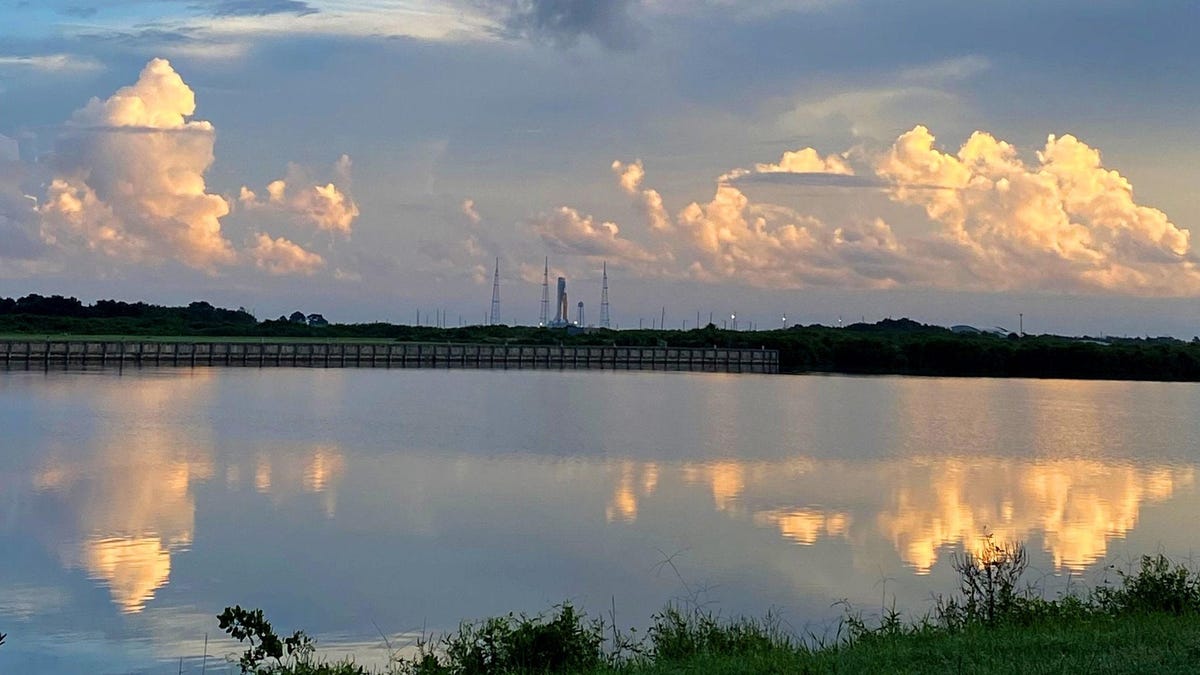A serious and unmanageable hydrogen leak prevented NASA from launching its SLS rocket on Saturday. Teams continue to evaluate the reason for the second failed launch attempt, but NASA says the rocket will have to return to the Vehicle Assembly Building to undergo safety checks.
For rocket scientists, hydrogen is an important propellant, but it’s also a serious pain in the ass. It’s the tiniest molecule in the universe, and as such, it has a propensity to leak out through tiny gaps and cracks. Hydrogen leaks bedeviled the Space Shuttle program, and now SLS—a rocket heavily modeled after the Shuttle launch system—is likewise experiencing problems with hydrogen leaks.
The most recent leak, which prevented the Space Launch System from blasting off today, was more severe than the one experienced during the first launch attempt on Monday, Mike Sarafin, Artemis mission manager, told reporters during a press briefing held earlier today. “This was not a manageable leak,” he said, saying pre-planned procedures to fix the problem failed to work. Ground crews were able to resolve a hydrogen leak on Monday, but the techniques applied today “were not working in our favor,” Sarafin said. Three different attempts were made today to fix the problem. None worked. Today’s launch was supposed to happen within a two-hour window that opened at 2:17 p.m. ET.
Jim Free, associate administrator for Exploration Systems Development Mission Directorate at NASA said that the current launch period, which ends on Tuesday, September 6, is now “off the table.” The next launch attempt for SLS could happen within a period that runs from October 17 to 31. “We do not launch until we think it’s right,” said NASA administrator Bill Nelson during today’s briefing. He reminded reporters that the Shuttle got sent back to the Vehicle Assembly Building (VAB) on more than 20 occasions.
NASA officials are currently devising a plan to move forward with the rocket. Repairs could be done either while the rocket remains on Launch Pad 39B at Kennedy Space Center or inside the VAB nearby. During tanking on Saturday, a line in the 8-inch quick disconnect appeared to have been affected by an inadvertent over-pressurization. Sarfin said this might be a cause, and possibly the root cause, of the hydrogen leak. At today’s press briefing, Free said the large hydrogen leak at the quick disconnect was different than the one experienced on Monday.
G/O Media may get a commission
The team has decided to perform a “remove and replace” of the “soft goods” (i.e. non-metallic materials) at the quick disconnect. The team must now decide if that work will be done on the pad or in the VAB. The preference would be on the pad, Sarafin said, as tests could be done under cryogenic conditions, which is not the case inside the VAB. The team will make its decision on the matter at some point next week.
Regardless, the 322-foot-tall (98-meter) rocket must return to the VAB to satisfy range requirements; the current permit is set to expire, and safety regulations stipulate that SLS’s flight termination system must be retested inside the VAB. “It’s a relatively short retest of the flight termination system just to provide confidence to the range that…the public will be safe,” Jeremy Parsons, deputy program manager of Exploration Ground Systems at Kennedy Space Center, told reporters on Friday.
The NASA officials said the delays in getting SLS off the ground won’t affect the Artemis program overall. Nelson said NASA is still aiming for the launch of Artemis 2 (a crewed flight around the Moon) in 2024 and the launch of Artemis 3 (a crewed landing on the lunar surface) in 2025. NASA’s Artemis program seeks a sustainable and permanent return to the lunar environment, and as a stepping stone for eventual crewed missions to Mars. For the first Artemis mission, SLS will send an uncrewed Orion spacecraft on a multi-week mission to the Moon and back.
Stay connected with us on social media platform for instant update click here to join our Twitter, & Facebook
We are now on Telegram. Click here to join our channel (@TechiUpdate) and stay updated with the latest Technology headlines.
For all the latest For News Update Click Here

